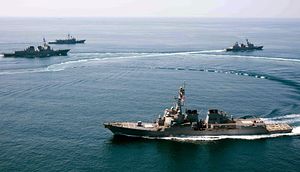On October 27, 2015, the USS Lassen, an Arleigh Burke-class guided-missile destroyer sailed within 12 nautical miles of Subi Reef and other features in the Spratlys. The Lassen’s operation was the first of three innocent passage freedom of navigation operations (FONOPs) served up by the U.S. Navy in the South China Sea since China constructed seven artificial islands in the Spratlys.
Next, 95 days later, on January 30, the USS Curtis Wilbur, another Arleigh Burke-class vessel, sailed within 12 nautical miles of Triton Island in the Paracel Islands, carrying out the second FONOP.
Finally, 105 days after the Curtis Wilbur‘s FONOP, on May 10, the USS William P. Lawrence, another guided missile destroyer, sailed within 12 nautical miles of Fiery Cross Reef, exercising innocent passage. In addition to complying with innocent passage requirements under the United Nations Convention on the Law of the Sea (UNCLOS), all three FONOPs also protested prior notification requirements.
Since that last FONOP in May, 120 days have elapsed and the U.S. Navy has not challenged excessive maritime claims by China and other South China Sea claimants. Moreover, in the meantime, a five-judge tribunal at the Permanent Court of Arbitration handed down the most consequential legal decision regarding China’s expansive maritime claims, clearing the path for perhaps the first high seas-assertion FONOP within 12 nautical miles of a Chinese artificial island, namely Mischief Reef.
When the Obama administration kicked off the FONOPs in the South China Sea, it wasn’t seeking attention in the international press, but it was looking to keep up a regular drumbeat. U.S. Defense Secretary Ashton Carter and other senior U.S. officials have clarified that the U.S. Navy’s FONOP program is meant to be regular and mundane (see the official U.S. fact sheet on the program here). Above all, FONOPs are not meant to be reactions to specific tactical stimuli or provocations from China or other claimants. Nor are FONOPs meant to serve as a deterrent tool.
However, the ongoing delay between the William P. Lawrence FONOP and the yet-to-be-held fourth South China Sea FONOP calls into question some of the claims underlying the U.S. FON agenda in the South China Sea. For instance, it would not be unreasonable to suggest that the Pentagon held off on the fourth FONOP ahead of the Hangzhou G20 meeting and the ongoing series of ASEAN summits in Vientiane, Laos.
Despite the mundane, legal signaling rationale behind FONOPs, China regards them to be highly provocative. A FONOP in mid-August would have kept in line with roughly the intervals that had elapsed between the first, second, and third FONOPs, but would have borne costs for Obama in Hangzhou, where he held what will likely be his last official meeting with Chinese President Xi Jinping.
What’s puzzling–and frankly regressive–is that the United States is letting the door close on what would have been perhaps the most forceful way of throwing its support behind the July 12 award by the tribunal at the Permanent Court of Arbitration. In his letter to Senator John McCain last December, clarifying the Lassen operation, Carter had clarified that the United States faced “factual ambiguity” in planning the operation near Subi Reef. The tribunal’s award resolved many of those ambiguities and simplified matters considerably by deciding that no Spratly feature, including Itu Aba, was an island entitled to a 200 nautical mile exclusive economic zone.
Most importantly, the tribunal decided that Mischief Reef, where China has built an artificial island, is part of the Philippines’ continental shelf. The U.S. Navy should have moved to assert high seas freedoms around Mischief Reef, which was additionally found by the tribunal to be a feature submerged at high tide in its natural condition, and thereby not entitled to any 12 nautical mile territorial sea. Mischief Reef clearly offers the highest value FONOP target for the United States if it wants to fully throw its weight behind the July 12 award and show support for the Philippines.
Of course, the reality of FONOPs, despite what Carter and other officials claim, has been quite different from the theory. The diplomatic calendar and the broader U.S.-China agenda bear on where and when the United States sails its destroyers. A Mischief Reef FONOP, though attractive for the reasons outlined above, would also be perceived as immensely provocative by the Chinese side, affecting Beijing’s willingness to play nice with Washington on other issues in the Asia-Pacific.
Still, even if Mischief Reef is a bridge too far at this point, Washington is slowly eroding the credibility of the FONOP as a mundane signaling tool by making it appear like anything but a scheduled drumbeat. With the fourth operation potentially delayed by over a month, China’s point that Washington “places its own interests above international law” will begin to ring truer. At this point, if the latest murmurs of China increasing the presence of Chinese Coast Guard vessels near Scarborough Shoal pan out, the fourth U.S. FONOP may look like a reaction to that specific event and less like just something the United States Navy does in the South China Sea.
For FONOPs to work and have their desired legal signaling value, they need to essentially be boring and regular. If Washington doesn’t keep to a schedule and opts to practice careful timing, it may see short-term diplomatic dividends (or not, judging by the U.S.-China Hangzhou kerfuffles and ongoing tension over THAAD). However, tinkering with the FONOP formula risks losing sight of longer term strategic objectives.

































